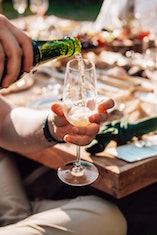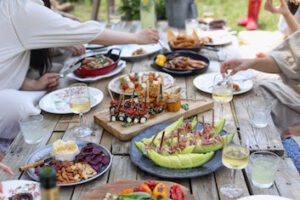While other parts of speech have rules governing where they are placed – for example, verbs need to be the first or second element in a sentence – adverbs can float around quite happily. Often we use them at the start (as you can see where the adverb often is used in this sentence) to create a lively opening for a sentence.
But there are some dangers, particularly with those words that can be used as either adjectives or adverbs. Consider these sentences:
- Only Graham drank champagne at the Cup Day barbecue.
- Graham only drank champagne at the Cup Day barbecue.
- Graham drank only champagne at the Cup Day barbecue.
- Graham drank champagne only at the Cup Day barbecue.
- Graham drank champagne at the Cup Day barbecue only.

The placement of only in each of these sentences makes the meaning of each slightly different, and means that sometimes only is acting as an adjective and sometimes as an adverb.
Only Graham drank champagne at the Cup Day barbecue. Here only is an adjective, and describes Graham. The meaning is that no one else apart from Graham had champagne; all the other guests drank something else.
Graham only drank champagne at the Cup Day barbecue. Now only is adverb, describing the verb drank. The meaning is a little strange: this sentence means the only activity that Graham used champagne for was drinking. Graham didn’t spill the champagne, or open it, or finish it, or spray it around when he backed the winner – all he did with the champagne was drink it.
Graham drank only champagne at the Cup Day barbecue. Only is back to being an adjective, this time describing champagne. The meaning is now that Graham didn’t have any other drinks; champagne was the sole type of drink that he had.
Graham drank champagne only at the Cup Day barbecue. Only has flipped back to adverb again; this time it is starting an adverbial phrase describing when the drinking takes place, which is the at the Cup Day barbecue; he doesn’t drink champagne in any other time. (I will talk about types of phrases in a future post; if you don’t quite understand why only is adverb here, you can either investigate the types of phrases yourself, or remember that one of the functions of adverbs is to describe when something happens, which is what the word is doing in this sentence).
Graham drank champagne at the Cup Day barbecue only. And now only is back to being an adjective, this time describing barbecue. You may have spotted in the previous sentences that only described the word that followed it; here, with no following words, it can only describe the previous word. The meaning is now that the barbecue was the sole meal or event on Cup Day where Graham drank champagne; not at the Cup Day breakfast, not at the Cup Day dinner but just at the Cup Day barbecue. (It is also possible to read this sentence as meaning the same as the previous one: the Cup Day barbecue is only place where Graham has some bubbly alcohol, but the better way to create that meaning is to use the structure of the previous example.)

Only is often used in the wrong spot in sentences, so please take care with it, whether you have had any champagne or not, and put it immediately before the word or group of words it is meant to describe. In general, unless you are trying to create a particular effect with unusual placement of words, adverbs are best placed immediately before the words they are meant to describe.
Here’s to you, Graham (and I know you would have actually preferred red wine)!

If you have found this post interesting, you can find a full index to my other posts on the index page. To be notified when I post a new topic, follow me on Facebook! If you have any particular questions you’d like me to answer in future posts, just send me a message. I’m always interested to learn what people think, and how you came across this site, so please post a comment.
If you think you would be interested in either my complete grammar course or an individual customised online course (particularly suited for people who don’t live in Melbourne), just click your preferred option.